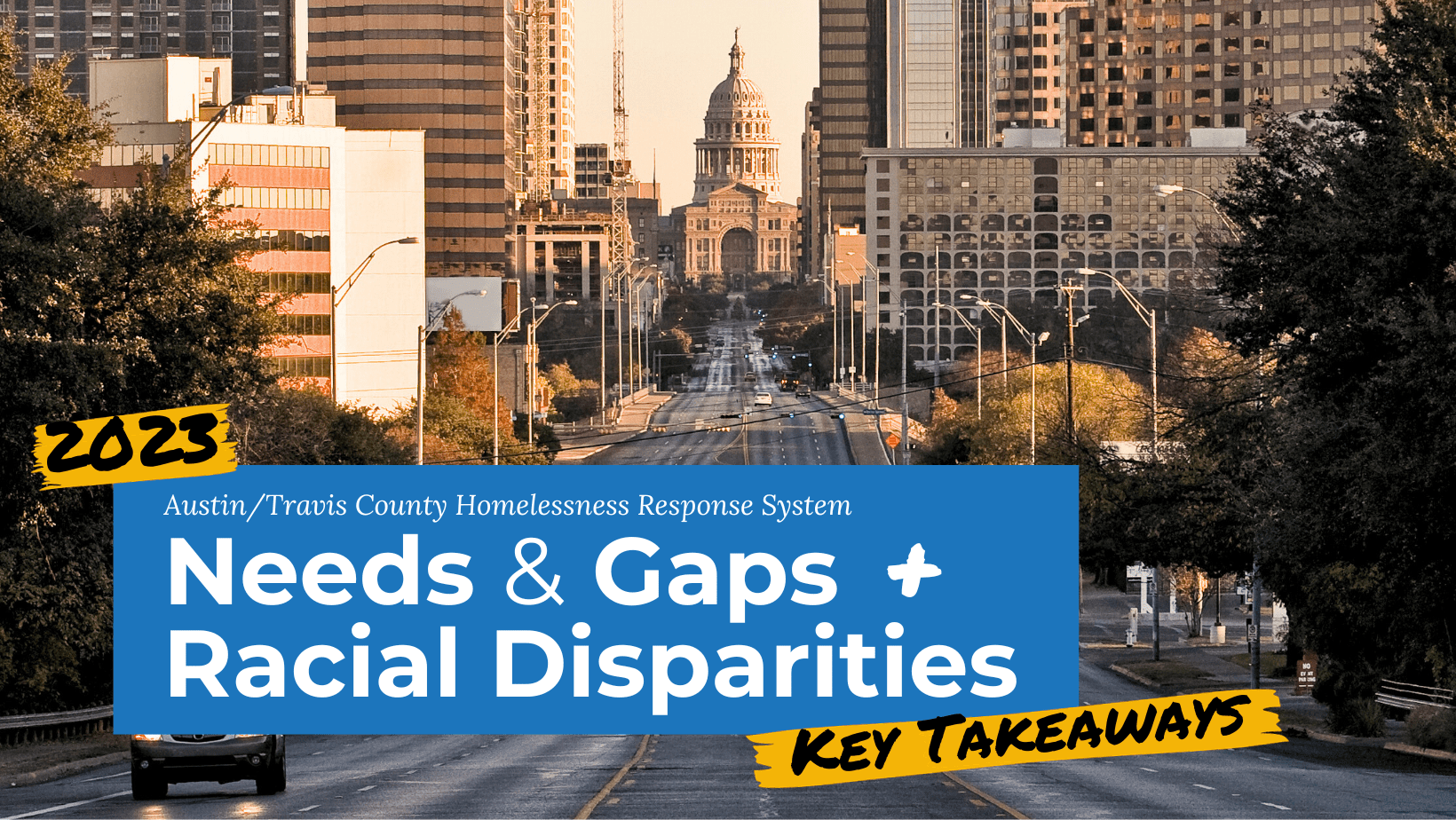What to Know: Takeaways from two reports on the Austin/Travis County Homelessness Response System
AUSTIN (Sept. 26, 2023) — People living outside in Austin and Travis County are connecting more quickly to organizations that can offer help due to targeted expansion of our community’s outreach system. At the same time, the unaffordability of the area’s housing market continues to drive a racial wedge between who stays housed and who doesn’t. These are among the findings in two reports on the Austin/Travis County Homelessness Response System (HRS) that ECHO publishes annually, the Needs & Gaps (PDF) and Racial Disparities (PDF) reports.
ECHO’s Research & Evaluation Team analyzed data from 2022 in the Homeless Management Information System (HMIS), a person-level database service providers use to help people end their homelessness, to prepare the reports. They’re intended to guide policy and investments within the HRS toward areas of greatest need.
This guidance is increasingly important as our HRS continues to grow to meet our community’s needs. Between 2021 and 2022, service providers working in our HRS added 15 new programs, from street outreach to shelter to housing. Throughout the course of the year, these programs served a total of 16,164 people. (This number includes everyone who was enrolled in any HRS program for any amount of time during the year, including people who remained in permanent housing programs after enrolling in prior years. It is not an estimate of the number of people experiencing homelessness in Austin.)

Here are four key takeaways from the two analyses.
1. Collaborative outreach efforts are connecting more people to housing assessments and crisis services faster.

In 2022, compared to the year before, community assessors saw a 55% increase in the number of people doing their first Coordinated Assessments (CAs), a single housing needs evaluation used to help people easily enroll in more than 20 housing programs in our community in a streamlined fashion as openings arise. Our system also saw a 55% increase in the number of Street Outreach projects year to year. This expansion, the result of targeted investments through the Austin Street Outreach Collaborative (ASOC) and other initiatives, means there are more ways for more people to access services and more data being collected through those programs. The result is that the median amount of time someone waits between the day they become unhoused and the day they do their first CA is significantly lower – about four months in 2022 compared to nearly eight months in 2021.
ASOC partners are largely responsible for a significant increase in the number of people who end their homelessness with minimal intervention from the HRS. The number of people using these light-touch services grew by 54%, and about three-fourths of that increase is attributable to direct aid funding available through the ASOC partnership. Current funding for the ASOC expires in spring 2024.
This kind of coordinated outreach system is dramatically expanding our ability to connect quickly with people who need places to live. However, our ability to rehouse people who want and need a more involved intervention is dependent on the number of units in our HRS. Because the vast majority of units people have access to are rentals through the private market, Austin and Travis County’s tight housing market makes finding a place to live much harder, even with rental assistance and a case manager. “In other words, an available slot in a permanent housing project still does not mean there is any available or accessible affordable unit in Austin and Travis County for that person to rent,” Christopher Murray writes in the Needs & Gaps report.
2. More people in housing programs are reporting disabling conditions and would benefit from more robust community-based supports.
The percentage of people moving into housing through the HRS who report disabling conditions is rising. Seventy-seven percent of people in Rapid Re-Housing (RRH) projects in 2022 reported a disabling condition, up 7 percentage points from the year before. A disabling condition can include a physical, mental, or developmental disability; chronic health conditions, including HIV/AIDS; and substance use. The percentage of people in Permanent Supportive Housing (PSH) reporting disabling conditions held steady at 85 percent.
RRH includes housing search assistance and short- to medium-term rental assistance with case management to help people increase self-sufficiency and remain stable and permanently housed after moving on from the program. PSH includes long-term rental assistance and individualized supportive services and is designed for people with disabling conditions who’ve experienced chronic homelessness. Our community needs to continue growing our supply of both these housing interventions.
Because RRH programs are time-limited, and because there are more of these units available in our community, RRH spots tend to open more often. People eligible for PSH can choose an RRH program if it becomes available first, and many do. When people move on from any housing program, there are often not the same kinds of community-based services that provide support to remain stably housed. Our entire community would benefit from stronger support networks separate from the HRS to help provide wraparound care after programs end. And community-based support doesn’t just help people ending their homelessness; these kinds of supports can help prevent homelessness in the first place.
The HRS has been making positive strides. We expect people to be moving into 300 new units of PSH by the end of the year, the first of more than 1,000 new units anticipated in our community by the end of 2026. At the same time, our community has seen growth in our RRH capacity starting in 2020 as the result of several one-time funding streams. Funding from some of these sources, like the American Rescue Plan Act (ARPA), will soon be expiring, and some, like the CARES Act, have expired already. Given this reality, Murray writes, “it is important to begin planning now,” through more sustainable funding sources, “to keep up with the system’s need for additional RRH projects and to avoid experiencing yet another decrease in RRH capacity, enrollments, and move-ins in 2025.”
3. A Black Austinite is still six times more likely to experience homelessness than a white Austinite.
This is the least surprising and perhaps the most important takeaway. The forces that push people into homelessness continue to disproportionately affect Black people in our community. These forces are outside the control of the HRS – the affordability of housing; the availability of jobs, healthcare, and educational opportunities; the explicit targeting of BIPOC communities by law enforcement and the criminal legal system – yet they directly influence who our system serves. While Black people make up less than a tenth of the population in Austin and Travis County, about a third of people experiencing homelessness here are Black.
BIPOC Austinites experiencing homelessness also tend to be younger than unhoused white people and are more likely to be part of multi-member households. About a quarter of Black people and nearly a third of Hispanic/Latinx people were under 18. By comparison, only about 5 percent of people who identify as white were minors. Thirty-seven percent and 42 percent of Hispanic/Latinx and Black people, respectively, were part of family households in 2022, compared to 10 percent of white people.

A bright note in our HRS’ efforts toward racial equity is the increase in the number of Black and Hispanic/Latinx people referred to PSH for the first time. White people continue to make up the majority of people served by these programs, but 2022 saw positive shifts toward equity in who is referred to housing. When people are ready to move on from these programs, however, the data show fewer Black people (about half) move onto another permanent place to live than white and Hispanic/Latinx people (about two thirds). “Although the Austin/Travis County Homelessness Response System (HRS) has made strides over the course of 2022 to address racial and ethnic disparities—by funding new agencies, increasing outreach efforts, and working to improve the Coordinated Assessment—there is still much work to do in the HRS and the broader community,” Sara Fuetter notes in the Racial Disparities report.
4. Austin’s housing market is a key driver of the racial gap between who stays housed and who doesn’t.
As Austin’s housing market becomes increasingly unaffordable, the effects fall disproportionately on BIPOC communities. A person living in Austin needs to make $77,640 in net annual income to reasonably afford the seasonally adjusted average rent here. Due to systemic racism in the systems noted above (along with many others), low-income workers in communities across the country, including ours, are disproportionately BIPOC workers.
Meanwhile, new residents moving to Austin and Travis County are disproportionately white. Historically Black and Hispanic/Latinx neighborhoods are gentrifying as a result, and we’re seeing the impact in who ends up unhoused. During the housing assessment process, Black and Hispanic/Latinx people are about twice as likely as white people to report being born and/or raised in Austin. More than two-thirds of Black and Hispanic/Latinx people born and/or raised here reported living in a gentrified zip code before becoming unhoused, compared to half of white people.
Rising costs impact everyone in our community, but their worst effects are felt by folks with often the deepest roots in their neighborhoods. “This decrease in affordability can lead to housing displacement and overall housing instability,” Fuetter writes, “which in turn can lead to difficulty in finding stable housing, increased risk of eviction, and difficulty in accessing services if an individual is forced out to the outskirts of a city.”



